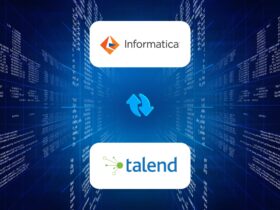Importance of having a data strategy to build modern data platforms
A modern Data Platform serves asan architecture for Business Analytics. It is one of the building blocks of digital transformation that uses the data’s power to reveal patterns and make predictions. Modern data and analytics platform allow us to gather, store and process data of all types and sizes from any data source. This deeper understanding gives an important insight and helps in identifying trends and risks that eventually help in shipping on time, provide a quality product for the customers, cut down on business costs and optimize internal operations. An enterprise requires a road map to harness the potential of data-driven capabilities. This is referred to as enterprise data strategy.
An enterprise data strategy enables big data analytics of an organization. The volume, velocity and variety of data, including structured and unstructured data, requires unprecedented focus on managing big data. The use of sophisticated tools and techniques to handle these massive data sets are inevitable. In order to efficiently use the data to draw useful insights and direction, putting together an enterprise data strategy should be a fundamental responsibility of any organization. A data strategy should represent for all domain-specific strategies like big data management, business intelligence, big data etc.
Before going further into data strategies, let us look at the issues faced by a business without data strategy.
- Most projects across the organization required access to the same data content. Without a data strategy, there is no coordination to prevent overlapping work.
- There is no data sharing, data reuse or any economic activities to simplify or reduce the cost of data movement and development.
- Data value names and formatting varies across applications. This results in improper collection of data when business users try accessing data across multiple applications.
- Reports generated are found to be inconsistent as the source data was not consistent and not one single data source was documented.
To effectively overcome the above-mentioned hiccups in dealing with big data, data strategy is designed to improve all the ways data can be acquired, stored, managed, shared and used.
The five core components of data strategy are:
- Identify: The most basic element while sharing data within an organization is to identify and understand the meaning of it regardless of its structure, origin or location. Data can be either structured or unstructured and thus manipulating and processing the data is not easy unless the data has a defined format and value representation. The lack of data identification results in extra analysis effort every time the data is processed.
- Store: One of the most difficult and yet entirely necessary discipline of any organization is to efficiently store the data. Storing the data persistently in a structure and location that supports easy, shared access and processing is the key factor. Each application is provided with its own storage to support the processing requirements. The data needs to be centrally merged so it can be easily shared among many applications to support the individual needs. To aid this, it is very critical to make the storage efficient with simplified access. A good data storage should ensure the availability of any data created across any application without creating a copy.
- Provision: Once again emphasis is laid on sharing the data across platforms and applications. In the initial days, an application would be built and maintained independently. Data was stored and used according to the convenience of that application only. This resulted in duplicating the data if any other application needed the same data. With the increase in the number of applications and the volume of data, this approach will not be feasible across a huge organization. This gave rise to packaging of data so it can be shared, reused, provide rules and access guidelines for the data. Data being the corporate asset of an organization, the more effective it is managed across applications, the better the company can save both financial efforts and manual efforts.
- Process: Majority of the available data cannot be used directly in any application. The data must go through a lot of wrangling in order to extract the desired results from it. Data generated can either be internal or external to an organization or from more than one system. This is the stage where processing of the data becomes critical. Processing of data mainly includes moving and combining data existing in disparate systems and provide a unified and consistent data view. Centralizing the data and managing its access from all the applications also might not work out as the data need of each application differs. Thus, making data ready to use is only by offering tools and establishing processes to produce the data that individual can use at any time.
- Govern: This step primarily is to establish, manage and communicate information policies and mechanisms for effective usage of data. As the data is shared among applications, it undergoes plenty of changes. Data governance ensures the necessary rigor over the data content as changes occur to the technology, processing and methodology areas associated with the data strategy efforts.
For most of the data driven companies, building data platforms that are grounded first in business strategy and which are responsive to the needs of the organization and customer needs are effective. Organizations need to make the necessary changes by aligning to the data strategy with modern data platform development in order to thrive.
The efficiency of the AI/ML initiatives of a company is fueled by the form of data and the steady supply of it. A company needs to excel at data engineering and business analytics fundamentals even before jumping into ML/AI. A data strategy is like a backbone for an AI strategy. A data strategy for AI enables a company to look at data from an AI-ready perspective and not in an IT-centric view. The data simply does not show what happened, but also used as a means of showing what could happen and how. An enterprise data strategy must be designed and carried out by a cross-functional team of business leaders, data scientists and IT. With an efficient use of data strategy, data can be made AI-ready. Data is being drawn from a lot of sources and like mentioned above, data strategy is the best solution to collect and process data in a format that the project needs. Data can be either internal or external to the organization. This can create a gap in the wrangling process, and this must be addressed too. Thus, defining a clear strategy stands very critical for AI initiatives and directly determines the success of the deliverables.










